

The 160kg Frome hoard, discovered in 2010, is the largest from Roman Britain found in a single container! #hoards. Remains of 'extraordinary' Roman arcade found in Colchester. Consisting of a covered walkway, enclosed by a line of arches on both sides, to provide shelter for pedestrians, it was built as the frontal structure for the Temple of Claudius, erected around 50 years earlier.

During her sacking of the town in 60 or 61 AD, Boudicca had razed the temple, where Colchester’s citizens had sought refuge, and the arcade is thought to have been part of the Romans’ attempt to rebuild the settlement and re-impose their domain across Essex and East Anglia. Archaeologists say the landmark discovery confirms the strength and sophistication of Roman culture in Colchester, the first Roman city in Britain and founded as a colony for retired Roman soldiers. The latest find was made by the Colchester Archaeological Trust and will go on permanent public display this summer, beneath three glass panels. Phillip Crummy, the archaeological trust's director told The Telegraph: “This arcade is the largest of its kind in Britain.
Emperor Claudius How the arcade would have looked. Archaeology Articles : The Cheshire Hoards, Roman archaeology collections of recent finds. List of Roman villas in England. From Wikipedia, the free encyclopedia A list of Roman villas in England confirmed by archaeology.
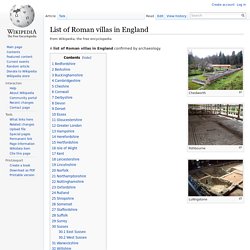
§Bedfordshire[edit] §Berkshire[edit] §Buckinghamshire[edit] §Cambridgeshire[edit] §Cheshire[edit] Des bijoux vieux de 2 000 ans découverts sous un grand magasin au Royaume-Uni. Cirencester's Roman amphitheatre plan adopted. Shrewsbury hoard of Roman coins to go on display. 4 March 2013Last updated at 16:19 ET The coins are mainly bronze, dating back to the 4th Century The largest collection of Roman coins discovered in Shropshire is to go on public display.
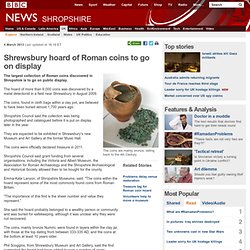
The hoard of more than 9,000 coins was discovered by a metal detectorist in a field near Shrewsbury in August 2009. The coins, found in cloth bags within a clay pot, are believed to have been buried almost 1,700 years ago. Shropshire Council said the collection was being photographed and catalogued before it is put on display later in the year. They are expected to be exhibited in Shrewsbury's new Museum and Art Gallery at the former Music Hall. The coins were officially declared treasure in 2011. Dovedale Roman and Iron Age coins found after 2,000 years.
6 July 2014Last updated at 21:15 ET Experts say the find is highly unusual as it is the first time coins from these two separate civilisations have been buried together A precious hoard of Roman and Late Iron Age coins has been discovered in a cave where it has lain undisturbed for more than 2,000 years.
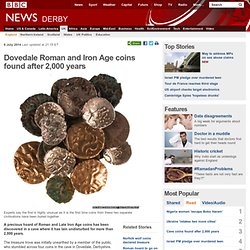
The treasure trove was initially unearthed by a member of the public, who stumbled across four coins in the cave in Dovedale, Derbyshire. The discovery prompted a full-scale excavation of the site. Experts say it is the first time coins from these two separate civilisations have been buried together. Continue reading the main story “Start Quote. IVe siècle – L'anneau qui inspira Tolkien. Un jour, au IVe siècle de notre ère, un Romain du nom de Silvianus se rend au temple celte dédié à Nodens, dieu de la guérison, situé sur une hauteur dominant la Severn, à Lydney, dans le Gloucestershire.
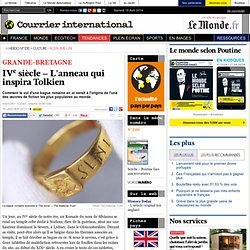
Durant sa visite, peut-être alors qu’il se baigne dans les thermes associés au temple, il se fait dérober sa bague en or. Si nous le savons, c’est grâce à deux tablettes de malédiction retrouvées lors de fouilles dans les ruines du site, au début du XIXe siècle. Le mystère des crânes tranchés de la Londres romaine. Mystery of 39 skulls found at London Wall is solved after 25 years: Decapitated heads were 'gladiators' who fought in the City.
Une exceptionnelle tombe romaine découverte en Angleterre par des étudiants. En Angleterre, des élèves de l’Université de Bournemouth ont fait une incroyable découverte près de Winterbourne Kingston.

C’est une tombe romaine vieille de 1.700 ans contenant cinq corps humains qui a été mise au jour par les archéologues amateurs. Avez-vous déjà partagé cet article? Partager sur Facebook Partager sur Twitter. Hoard of Celtic coins found in Leicestershire. 13 July 2012Last updated at 03:49 ET The coins are to go on display at Harborough Museum Ten gold coins dating back more than 2,000 years have been discovered in Leicestershire.

The coins, depicting horses surrounded by mysterious symbols, are believed to have been made in northern France or the Low Countries between 60-50 BC. Angleterre : un trésor vieux de 2000 ans découvert dans une grotte. Britain must dig deeper to save its archaeology - News - Archaeology. Although the recession cut the number of working archaeologists by a third, the economy is recovering, and experts now fear that there will not be enough trained archaeologists to meet the demand of developers.
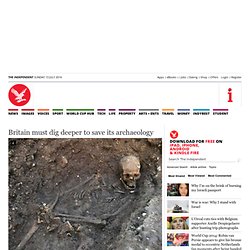
As a result, they are warning that further archaeological riches may be lost to the nation for ever. "These are one-off opportunities and, once you have lost a site, you have lost it for ever – you never get that knowledge back," says Mike Heyworth, director of the Council for British Archaeology. Poor job prospects and even poorer pay is exacerbating the problem. "Many archaeologists don't make enough to pay taxes," said Doug Rocks-Macqueen, a consultant for Landward Research Ltd. Roman skeleton discovery could rewrite British history. It could provide vital clues as to who was living in Britain around 350AD when the Roman Empire was beginning to decline.

Dr Miles Russell, a senior lecturer in archaeology at Bournemouth University, said: "This find is hugely significant because there have been more than 700 Roman villas found in Britain but before now no-one has ever found their occupants. "Our find could lead to graves of Roman villa owners all round the country being discovered.” Rare Iron Age coins found in Derbyshire cave after 2,000 years. Découverte d'un puits romain pratiquement intact en Angleterre.
Les archéologues de l'Université d'York ont découvert un puits pratiquement intact du romain tardif, près de Heslington.

Il pourrait avoir une signification dans les cycles agricoles locaux et les pratiques de fertilité de l'époque. Le puits, qui a probablement été utilisé pendant plusieurs décennies à la fin du 4e et début du 5e siècle, a été déterré lors de fouilles archéologiques sur le site du campus de l'Université, en cours d’agrandissement. Une conception soignée. Roman Settlement Unearthed in Devon, England. Bath House Found at Segedunum Roman Fort. The Romans had potholes too! 2,000-year-old road repairs unearthed in Devon. Wheel ruts were found during excavation of a road surface in DevonThey are thought to have been caused by carts driven over the surfaceSmall pieces of clay and rocks were found among the larger, flat rocksThis suggests they were laid after the original rocks had been placedExperts believe they are signs of repairs made by the Romans to fill the gaps and make the road smoother By Victoria Woollaston Published: 10:36 GMT, 21 July 2014 | Updated: 10:37 GMT, 21 July 2014 Potholes are the bug bane of every driver, but it seems that they're not a modern affliction.
Archaeologists have discovered that as far back as the Roman Empire, drivers were forced to deal with faulty and uneven road surfaces. Binchester Roman Fort Yields Well-Preserved Ring, Walls. Gods on the Roman Frontier. PEEP INTO THE PAST: Remarkable Roman frog is our ‘Object of the Year’ History can sometimes spring to life in unexpected ways – as the arrival at West Stow of this Roman figurine of a frog, found at Wixoe and on loan from Suffolk County Council Archaeological Services, demonstrates.
The frog is copper alloy; small – though not indeed perfectly formed, since it has only four ‘fingers’ instead of the five which it should have (if it is a common frog, Rana temporaria). Nevertheless, it represents a high point in terms of the workmanship which went into producing it; the modelling of the figurine has a fluid realism which is exceptional in Romano-British work of this period.